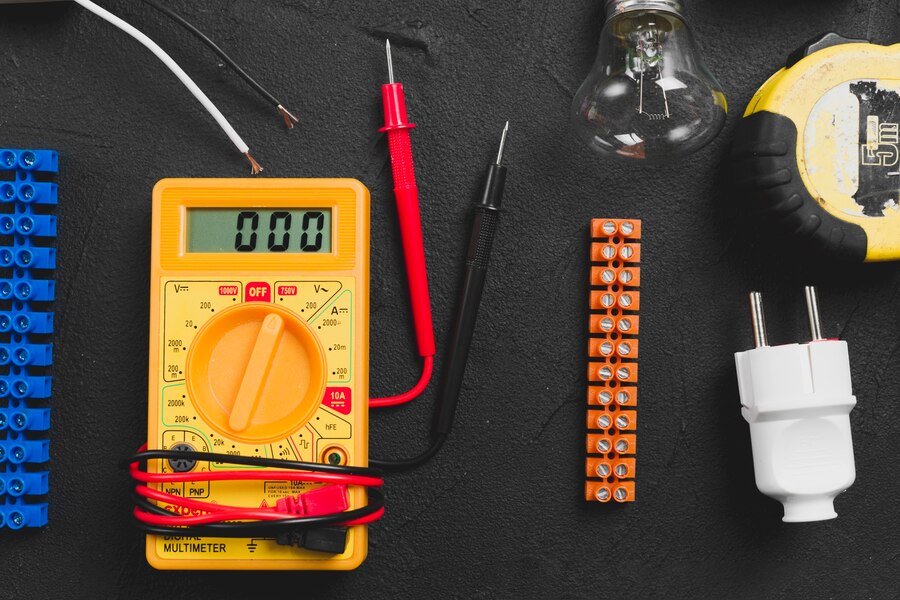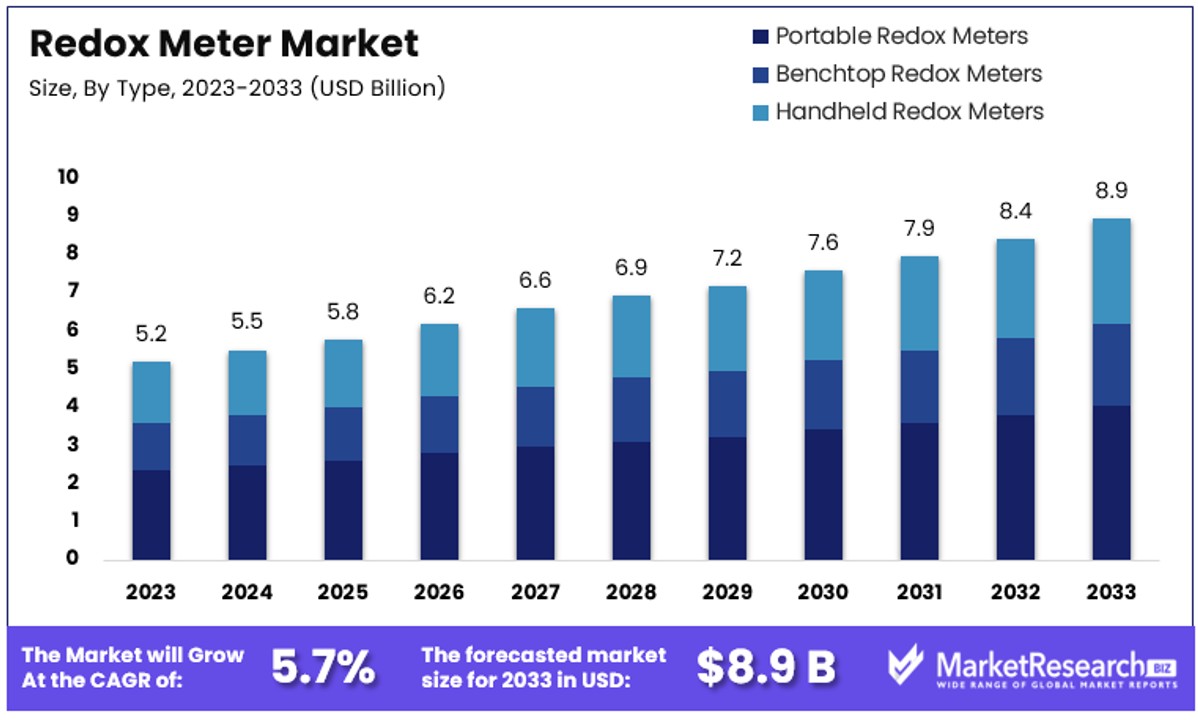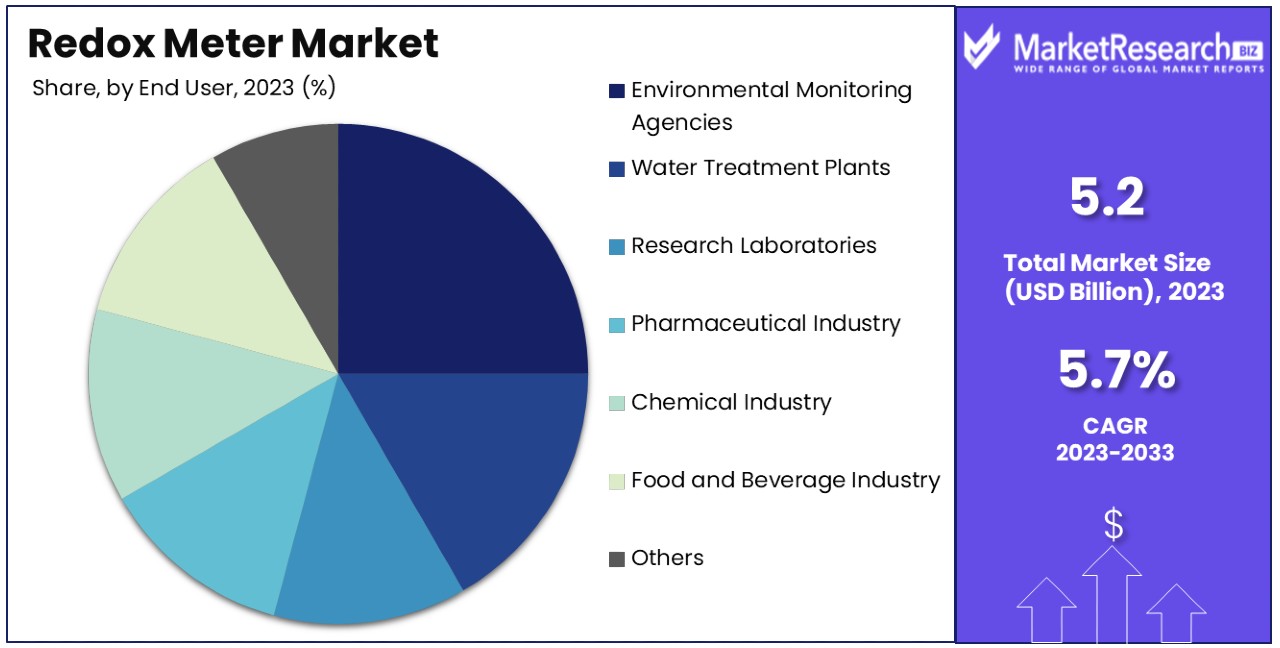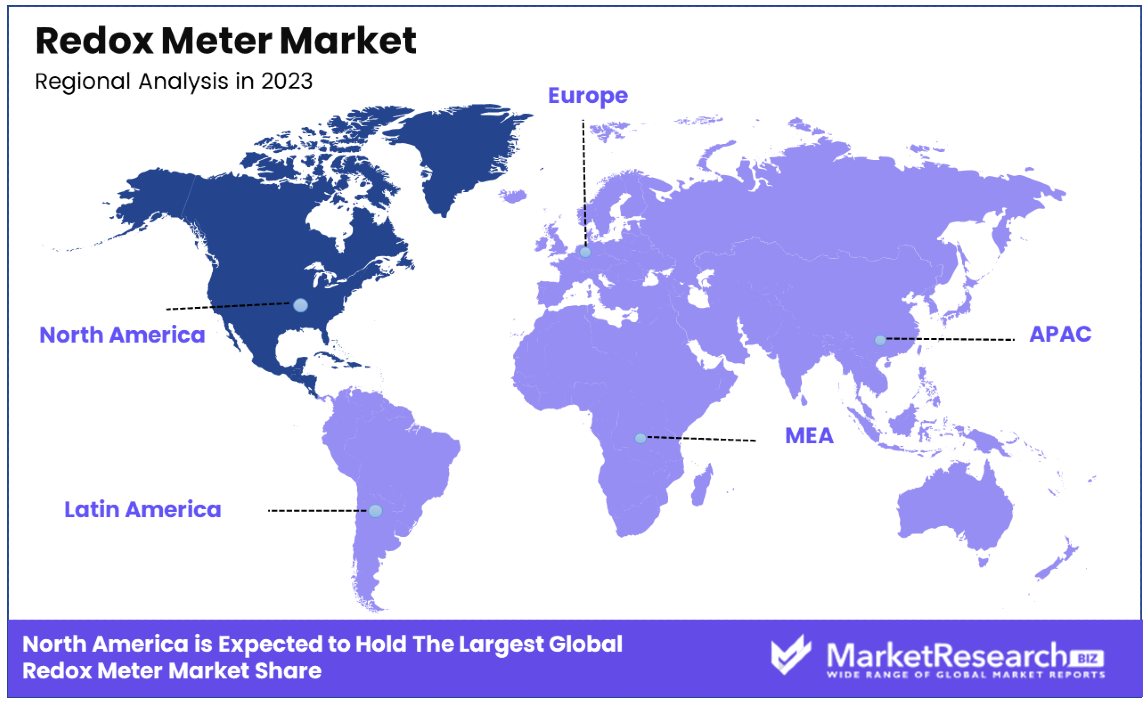
Redox Meter Market Report By Type (Portable Redox Meters, Benchtop Redox Meters, Handheld Redox Meters), By Application (Water Quality Monitoring, Industrial Process Monitoring, Environmental Monitoring, Laboratory Research, Others), By End User, By Region and Companies - Industry Segment Outlook, Market Assessment, Competition Scenario, Trends and Forecast 2024-2033
-
46110
-
May 2024
-
321
-
-
This report was compiled by Vishwa Gaul Vishwa is an experienced market research and consulting professional with over 8 years of expertise in the ICT industry, contributing to over 700 reports across telecommunications, software, hardware, and digital solutions. Correspondence Team Lead- ICT Linkedin | Detailed Market research Methodology Our methodology involves a mix of primary research, including interviews with leading mental health experts, and secondary research from reputable medical journals and databases. View Detailed Methodology Page
-
Quick Navigation
Report Overview
The Global Redox Meter Market size is expected to be worth around USD 8.6 Billion by 2033, from USD 5.2 Billion in 2023, growing at a CAGR of 5.7% during the forecast period from 2024 to 2033.
The Redox Meter Market encompasses the development, production, and distribution of devices used to measure oxidation-reduction potential (ORP) in various solutions. These precision instruments are essential in industries such as water treatment, chemical manufacturing, and pharmaceuticals, where accurate monitoring of chemical reactions and water quality is critical.
As environmental regulations tighten and the emphasis on process optimization grows, the demand for redox meters is increasing. This market serves as a barometer for industrial health and environmental stewardship, providing executives with the tools necessary for informed decision-making and strategic planning.

The Redox Meter Market is poised for significant growth, driven by increasing industrial and environmental monitoring needs. Redox meters, essential in measuring oxidation-reduction potential, are gaining traction in various industries such as wastewater treatment, aquaculture, and pharmaceuticals.
In high-income countries, 42% of wastewater is generated, with 82% collected and 74% treated. This robust infrastructure underscores the growing demand for accurate and reliable redox meters to ensure compliance with stringent environmental regulations.
Conversely, low-income countries lag, collecting only 9% and treating a mere 4% of their wastewater. This disparity highlights a significant market opportunity as these regions aim to improve their wastewater management systems, likely boosting the demand for redox meters.
The safe treatment of 56% of global household wastewater in 2020 further emphasizes the critical role of redox meters in maintaining environmental standards. The aquaculture sector also presents a substantial market opportunity. World aquaculture production of aquatic animals grew by 2.7% in 2020, reaching 85.4 million tonnes. Notably, Asia produced 91.6% of global aquatic animals and algae, signifying a concentrated demand for redox meters in the region to monitor water quality and optimize production.
In the European Union, aquaculture farming yielded almost 1.1 million tonnes of aquatic organisms in 2022, valued at €4.8 billion. This substantial output indicates a thriving market for redox meters, driven by the need for precise water quality monitoring to sustain high-value production.
Overall, the Redox Meter Market is expected to expand as industries prioritize environmental compliance and efficient resource management, underscoring its vital role in sustainable industrial practices.
Key Takeaways
- Market Value: The Global Redox Meter Market is anticipated to reach approximately USD 8.6 Billion by 2033, marking a notable increase from USD 5.2 Billion in 2023. This growth trajectory is attributed to a robust CAGR of 5.7% during the forecast period spanning from 2024 to 2033.
- Type Analysis: Benchtop Redox Meters dominate the market, commanding a substantial 55% share. These meters are favored for their precision and comprehensive functionality, making them indispensable in settings such as laboratories and industrial plants.
- Application Analysis: Water Quality Monitoring emerges as the dominant application segment, constituting approximately 40% of the market.
- End User Analysis: Water Treatment Plants lead the end-user segment, accounting for 35% of the market share. This dominance is fueled by the escalating global demand for clean water and the vital role of redox meters in ensuring water safety and compliance with regulations.
- North America dominates the Redox Meter Market with a significant 41.3% market share, reflecting the region's emphasis on water quality monitoring and industrial applications.
- Europe follows closely behind, holding approximately 27.8% of the market share, underscoring the widespread adoption of redox meters across various sectors.
Driving Factors
Increasing Demand from Water Treatment and Environmental Monitoring Industries Drives Market Growth
The growing importance of water purity and environmental health is significantly bolstering the demand for redox meters. In the context of water treatment facilities, redox meters are indispensable for assessing the oxidation-reduction potential, crucial in optimizing the use of disinfectants like chlorine. This ensures the effectiveness of the water purification process.
For instance, the U.S. Environmental Protection Agency mandates stringent ORP monitoring to meet the Safe Drinking Water Act standards, which has increased the adoption of redox meters. The environmental monitoring sector also contributes to this demand, driven by global initiatives to reduce pollution levels and maintain ecological balance. The synergy of stringent regulatory standards and the escalating need for sustainable water management practices exemplifies how interconnected industry requirements enhance the redox meter market’s growth trajectory.
Growth of Aquaculture and Aquarium Industries Drives Market Growth
The expansion of the aquaculture and aquarium sectors presents a robust growth avenue for redox meters. These devices are critical in maintaining high water quality, which is essential for the health and growth of aquatic life. Measuring ORP with redox meters helps in effectively managing the oxidation levels in water, thereby preventing the proliferation of harmful microorganisms.
As the global market for aquaculture is projected to grow at a CAGR of approximately 5.2% from 2023 to 2026, the demand for redox meters is expected to rise in parallel. This growth is further supported by the increasing popularity of home aquariums and the rising awareness of sustainable fish farming practices. Collectively, these trends underline the direct correlation between industry growth and the increased deployment of redox meters.
Expanding Applications in the Food and Beverage Industry Drives Market Growth
Redox meters are increasingly pivotal in the food and beverage industry, where they serve as essential tools for ensuring product quality and safety. The application of redox meters in monitoring the oxidation levels in beverages such as wine, beer, and juices helps in maintaining flavor consistency and preventing spoilage.
The global beverage industry, expanding at a steady pace, emphasizes stringent quality controls, thereby driving the adoption of redox meters. For instance, the wine industry, which is expected to witness a CAGR of around 3.7% over the next five years, relies heavily on precise ORP measurements to ensure the stability and quality of its products. The integration of redox meters into these production processes not only enhances product quality but also aligns with consumer expectations for safety and reliability, thereby promoting market expansion.
Restraining Factors
High Initial Investment Costs Restrain Market Growth
The high upfront costs associated with advanced redox meters represent a significant barrier to market expansion, particularly affecting small-scale operations and organizations with restricted budgets. These advanced meters, essential for precise water quality monitoring, are priced significantly higher than basic models, which can deter potential new entrants from adopting this technology.
For instance, while the average basic redox meter might cost around $150, more sophisticated models can exceed $500. This price disparity can be prohibitive for smaller entities, limiting the widespread adoption of these crucial devices in emerging markets or among financially constrained users. Consequently, the high initial investment required for advanced redox meters stifles the market's potential growth by restricting its accessibility to a broader audience.
Lack of Awareness and Technical Expertise Restrains Market Growth
The growth of the redox meter market is notably hindered by a dual challenge: a lack of awareness and a shortage of technical expertise. In many regions, particularly in developing countries, there is a substantial gap in understanding the importance and applications of redox meters. This lack of awareness reduces market penetration and slows down the adoption rate of redox meter technology.
Additionally, these devices require a certain level of technical skill for operation and maintenance, which is not always readily available. Training and retaining skilled personnel can be costly and time-consuming, posing another significant barrier. Together, these factors limit the market's expansion as they prevent potential users from fully integrating redox meters into their operational practices, thus stalling broader market growth.
Type Analysis
Benchtop Redox Meters dominate with 55% due to comprehensive functionality and precision.
Benchtop redox meters are currently the leading sub-segment within the types of redox meters, commanding approximately 55% of the market share. This dominance is primarily due to their extensive use in settings that demand high precision and functionality, such as laboratories and industrial plants. Benchtop models are preferred for their stability and advanced features, which include higher accuracy, connectivity options, and extensive data handling capabilities. These meters are integral in applications where continuous monitoring and precise control of water quality are critical, ensuring their widespread adoption in research and industrial sectors.
On the other hand, portable and handheld redox meters, although less dominant, play crucial roles in expanding the market's reach. Portable redox meters, known for their convenience and adaptability, are increasingly used in field applications and remote locations where benchtop units are impractical. This flexibility makes them ideal for environmental scientists and field technicians who require mobility without sacrificing accuracy. Handheld redox meters further extend the market’s footprint by offering compact, user-friendly options for quick spot-checks and immediate results. These meters are particularly popular in educational settings and smaller labs, where ease of use and cost-effectiveness are significant considerations. Together, these sub-segments complement benchtop meters by fulfilling the diverse needs of various end users, contributing to the overall growth of the redox meter market.
Application Analysis
Water Quality Monitoring dominates with 40% due to the critical need for clean water and regulatory compliance.
Water quality monitoring is the most significant application segment of the redox meter market, accounting for about 40% of its usage. The critical need for maintaining water purity and complying with global environmental standards drives this segment's preeminence. Redox meters are essential in monitoring oxidation-reduction potential, a key indicator of water's ability to cleanse itself of pollutants. This application is vital in various sectors, including municipal water treatment, industrial effluent treatment, and environmental monitoring, where stringent regulatory compliance is required.
While water quality monitoring holds the largest share, other applications like industrial process monitoring, environmental monitoring, laboratory research, and other specialized uses also contribute to the market dynamics. Industrial process monitoring utilizes redox meters to ensure the safety and efficiency of chemical reactions and manufacturing processes. Environmental monitoring uses these devices to assess the health of ecosystems and comply with environmental protection standards. Laboratory research, on the other hand, relies on precise and reproducible redox measurements for scientific studies and innovations. These diverse applications highlight the versatility of redox meters and their integral role in various fields, supporting the continuous expansion of the market.
End User Analysis
Water Treatment Plants dominate with 35% due to increasing global water treatment requirements.
Water treatment plants are the dominant end users of redox meters, making up about 35% of the market. This segment’s prominence is driven by the escalating global demand for clean and safe water, spurred by increasing population, industrialization, and stringent environmental regulations. Redox meters play a vital role in these facilities by monitoring and controlling the oxidation processes used to treat water, ensuring that it meets safety standards before it is deemed suitable for public use or returned to the environment.
Apart from water treatment plants, other significant end users include environmental monitoring agencies, research laboratories, the pharmaceutical industry, the chemical industry, and the food and beverage industry. Each of these sectors relies on redox meters for various critical functions, such as ensuring environmental compliance, conducting scientific research, and maintaining product quality and safety. For instance, in the pharmaceutical and food industries, redox meters are used to monitor processes that affect the shelf life and safety of products. In the chemical industry, these devices help in maintaining reaction conditions and ensuring process safety. Together, these diverse end-user segments underscore the essential nature of redox meters across multiple industries and their contribution to the market’s growth.

Key Market Segments
By Type
- Portable Redox Meters
- Benchtop Redox Meters
- Handheld Redox Meters
By Application
- Water Quality Monitoring
- Industrial Process Monitoring
- Environmental Monitoring
- Laboratory Research
- Others
By End User
- Environmental Monitoring Agencies
- Water Treatment Plants
- Research Laboratories
- Pharmaceutical Industry
- Chemical Industry
- Food and Beverage Industry
- Others
Growth Opportunities
Integration with IoT and Smart Monitoring Systems Offers Growth Opportunity
The integration of redox meters with Internet of Things (IoT) technology and smart monitoring systems represents a significant growth opportunity for the market. By enabling these meters to connect with wireless networks and become part of intelligent monitoring systems, users can access real-time data and analytics from anywhere.
This technological advancement not only enhances the efficiency of monitoring processes but also allows for more precise control over environmental conditions and water quality management. For instance, IoT-enabled redox meters can automatically adjust processes in water treatment plants based on the data they collect, optimizing both performance and resource use. Such capabilities are likely to drive greater adoption across multiple industries, leading to expanded market reach and increased profitability.
Development of Application-Specific Redox Meters Offers Growth Opportunity
The demand for redox meters tailored to specific industrial applications is creating substantial market opportunities. As sectors like brewing, pharmaceuticals, and environmental monitoring develop more specialized requirements, the need for custom-designed redox meters that cater to these unique conditions is rising.
Manufacturers who can innovate and produce meters specifically for these applications stand to gain a competitive edge. For example, a redox meter designed for the brewing industry might include features that optimize yeast fermentation, enhancing both product quality and production efficiency. This specialization not only meets the precise needs of end-users but also opens up new market segments, potentially boosting sales and market share for manufacturers focusing on niche markets.
Trending Factors
Adoption of Portable and Handheld Redox Meters Are Trending Factors
Portable and handheld redox meters are rapidly becoming a key trend in the market due to their convenience and versatility. These compact devices enable users to perform real-time measurements in various settings, including environmental field studies, aquaculture farms, and remote water quality monitoring sites.
The trend towards mobility in technology is compelling manufacturers to focus on making redox meters smaller, lighter, and more user-friendly, without sacrificing accuracy and reliability. As a result, the market is seeing an influx of innovative designs that cater to the needs of users who require mobility and ease of use. This shift towards portable and handheld devices is not only meeting current market demands but also opening up new opportunities for application in areas previously constrained by the need for stationary equipment.
Increasing Emphasis on Data Analytics and Process Optimization Are Trending Factors
The growing focus on data analytics and process optimization across various industries is propelling the redox meter market forward. Modern industries are increasingly dependent on data to enhance efficiency, reduce operational costs, and improve product quality. Redox meters equipped with advanced data logging and analysis capabilities are becoming indispensable tools in this regard. These meters facilitate precise monitoring and control of processes by providing detailed insights into oxidation-reduction potentials, which are crucial for maintaining optimal conditions in applications such as water treatment and manufacturing processes. The integration of these meters with process control systems is further driving their adoption, as businesses seek more sophisticated tools for data-driven decision-making and process optimization. This trend is fostering the development of next-generation redox meters that are not only more accurate but also integrated with broader industrial systems.
Regional Analysis
North America Dominates with 41.3% Market Share
North America's commanding 41.3% share of the global redox meter market is primarily driven by robust industrial growth, stringent environmental regulations, and significant technological advancements. The region's emphasis on regulatory compliance for water quality and environmental monitoring has necessitated widespread adoption of advanced monitoring equipment, including redox meters. Additionally, the presence of a highly developed research infrastructure and technological hubs has facilitated continuous innovation in this field, further boosting market dominance.
The regional dynamics in North America are characterized by a proactive approach to adopting new technologies and a strong focus on sustainable practices. These attributes have fostered a conducive environment for the growth of the redox meter market. The market benefits significantly from the integration of advanced data analytics and IoT capabilities into redox meter systems, enhancing their application in water treatment facilities, laboratories, and industrial processes across the region.

Regional Market Shares:
- Europe: Europe holds approximately 27.8% of the market share, driven by similar factors as North America, including strong regulatory frameworks and advanced technological infrastructure. The market here is poised for growth with increasing investments in environmental monitoring and quality control in manufacturing sectors.
- Asia Pacific: Accounting for 19.2% of the market, Asia Pacific is experiencing rapid growth due to expanding industrial activities and increasing environmental awareness. The region is expected to witness significant market expansion as more countries invest in water quality and industrial process controls.
- Middle East & Africa: This region captures about 6.7% of the market. Although smaller in comparison, it is growing steadily, fueled by developing infrastructure and increased environmental regulations in several countries.
- Latin America: Holding around 5% of the market share, Latin America’s market is gradually expanding with more focus on pollution control and investment in research and development activities in sectors like mining and agriculture.
Key Regions and Countries
- North America
- The US
- Canada
- Mexico
- Western Europe
- Germany
- France
- The UK
- Spain
- Italy
- Portugal
- Ireland
- Austria
- Switzerland
- Benelux
- Nordic
- Rest of Western Europe
- Eastern Europe
- Russia
- Poland
- The Czech Republic
- Greece
- Rest of Eastern Europe
- APAC
- China
- Japan
- South Korea
- India
- Australia & New Zealand
- Indonesia
- Malaysia
- Philippines
- Singapore
- Thailand
- Vietnam
- Rest of APAC
- Latin America
- Brazil
- Colombia
- Chile
- Argentina
- Costa Rica
- Rest of Latin America
- Middle East & Africa
- Algeria
- Egypt
- Israel
- Kuwait
- Nigeria
- Saudi Arabia
- South Africa
- Turkey
- United Arab Emirates
- Rest of MEA
Key Players Analysis
In the Redox Meter Market, several leading players have established themselves as key influencers due to their strong product portfolios, strategic positioning, and market penetration. Thermo Fisher Scientific Inc., Hanna Instruments, LLC, and Metrohm AG lead in terms of innovative technology offerings, emphasizing advanced, user-friendly interfaces and precise measurement technologies. These companies have also expanded their global reach through strategic partnerships and acquisitions, enhancing their market influence.
Another significant cluster includes Yokogawa Electric Corporation, Endress+Hauser Group, and Honeywell International Inc., known for their robust industrial automation solutions. These players integrate redox meters with broader control systems, appealing to sectors requiring precise chemical monitoring, like pharmaceuticals and water treatment.
Hach Company and Xylem Inc. specialize in water analysis solutions, providing integrated instruments that support environmental regulations compliance. Their focus on sustainability and regulatory approval has solidified their positions in sectors sensitive to environmental impact.
Emerson Electric Co., HORIBA, Ltd., and ABB Ltd. focus on integrating redox meters into broader analytical and monitoring solutions, targeting industries such as oil and gas, where precise chemical measurements are critical for process optimization and safety.
Lesser-known yet vital players like LaMotte Company, Electro-Chemical Devices (ECD), and OMEGA Engineering Limited cater to niche markets, offering specialized solutions that address specific customer needs, such as educational laboratories or small-scale industrial applications.
Overall, the strategic positioning of these companies within the Redox Meter Market showcases a blend of innovation, integration, and specialization, addressing diverse industry needs and regulatory environments. This strategic diversity not only drives competition but also pushes forward technological advancements and application-specific product development, underlining the dynamic nature of this market.
Market Key Players
- Thermo Fisher Scientific Inc.
- Hanna Instruments, LLC
- Metrohm AG
- Hach Company
- Yokogawa Electric Corporation
- Endress+Hauser Group
- Honeywell International Inc.
- Omega Engineering, Inc.
- Emerson Electric Co.
- HORIBA, Ltd.
- Xylem Inc.
- LaMotte Company
- Electro-Chemical Devices (ECD)
- OMEGA Engineering Limited
- ABB Ltd.
Recent Developments
- On May 2024, PCE Instruments launched the new PCE-PH 228, a combined pH and redox potential measuring instrument that can precisely determine the pH value and temperature of various liquids, as well as the redox potential in millivolts (mV) using an optional electrode.
- On January 2024, researchers from the Chinese Academy of Sciences, Tsinghua University and Hong Kong University of Science and Technology introduced a new method to effectively store iontronic energy based on osmotic effects and electrode redox reactions, realizing a vertical iontronic energy storage system.
Report Scope
Report Features Description Market Value (2023) USD 5.2 Billion Forecast Revenue (2033) USD 8.6 Billion CAGR (2024-2033) 5.7% Base Year for Estimation 2023 Historic Period 2018-2023 Forecast Period 2024-2033 Report Coverage Revenue Forecast, Market Dynamics, Competitive Landscape, Recent Developments Segments Covered By Type (Portable Redox Meters, Benchtop Redox Meters, Handheld Redox Meters), By Application (Water Quality Monitoring, Industrial Process Monitoring, Environmental Monitoring, Laboratory Research, Others), By End User (Environmental Monitoring Agencies, Water Treatment Plants, Research Laboratories, Pharmaceutical Industry, Chemical Industry, Food and Beverage Industry, Others) Regional Analysis North America - The US, Canada, & Mexico; Western Europe - Germany, France, The UK, Spain, Italy, Portugal, Ireland, Austria, Switzerland, Benelux, Nordic, & Rest of Western Europe; Eastern Europe - Russia, Poland, The Czech Republic, Greece, & Rest of Eastern Europe; APAC - China, Japan, South Korea, India, Australia & New Zealand, Indonesia, Malaysia, Philippines, Singapore, Thailand, Vietnam, & Rest of APAC; Latin America - Brazil, Colombia, Chile, Argentina, Costa Rica, & Rest of Latin America; Middle East & Africa - Algeria, Egypt, Israel, Kuwait, Nigeria, Saudi Arabia, South Africa, Turkey, United Arab Emirates, & Rest of MEA Competitive Landscape Thermo Fisher Scientific Inc., Hanna Instruments, LLC, Metrohm AG, Hach Company, Yokogawa Electric Corporation, Endress+Hauser Group, Honeywell International Inc., Omega Engineering, Inc., Emerson Electric Co., HORIBA, Ltd., Xylem Inc., LaMotte Company, Electro-Chemical Devices (ECD), OMEGA Engineering Limited, ABB Ltd. Customization Scope Customization for segments, region/country-level will be provided. Moreover, additional customization can be done based on the requirements. Purchase Options We have three licenses to opt for: Single User License, Multi-User License (Up to 5 Users), Corporate Use License (Unlimited User and Printable PDF) -
-
- Thermo Fisher Scientific Inc.
- Hanna Instruments, LLC
- Metrohm AG
- Hach Company
- Yokogawa Electric Corporation
- Endress+Hauser Group
- Honeywell International Inc.
- Omega Engineering, Inc.
- Emerson Electric Co.
- HORIBA, Ltd.
- Xylem Inc.
- LaMotte Company
- Electro-Chemical Devices (ECD)
- OMEGA Engineering Limited
- ABB Ltd.




